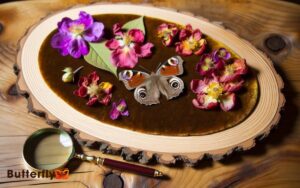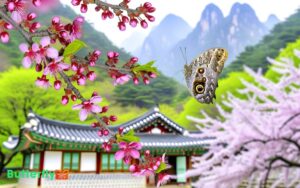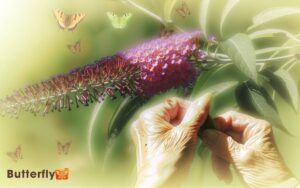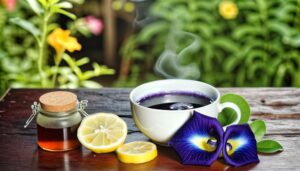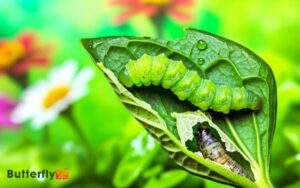10 Plants Butterflies Do Pollinate
Butterflies are essential pollinators for a range of flowering plants such as milkweed, asters, coneflowers, butterfly bushes, lantanas, zinnias, marigolds, lavender, and sunflowers. These plants offer crucial nectar sources, using vibrant colors and strong fragrances to attract butterflies.
The mutualistic relationship enhances pollination efficiency and supports biodiversity within ecosystems. Each plant, such as the milkweed, provides specific ecological benefits like breeding grounds or nutritional support for species such as Monarch butterflies.
Understanding these interactions enhances our appreciation of ecological interdependence and the critical role butterflies play in maintaining environmental health. Explore further to understand their broader ecological impact.
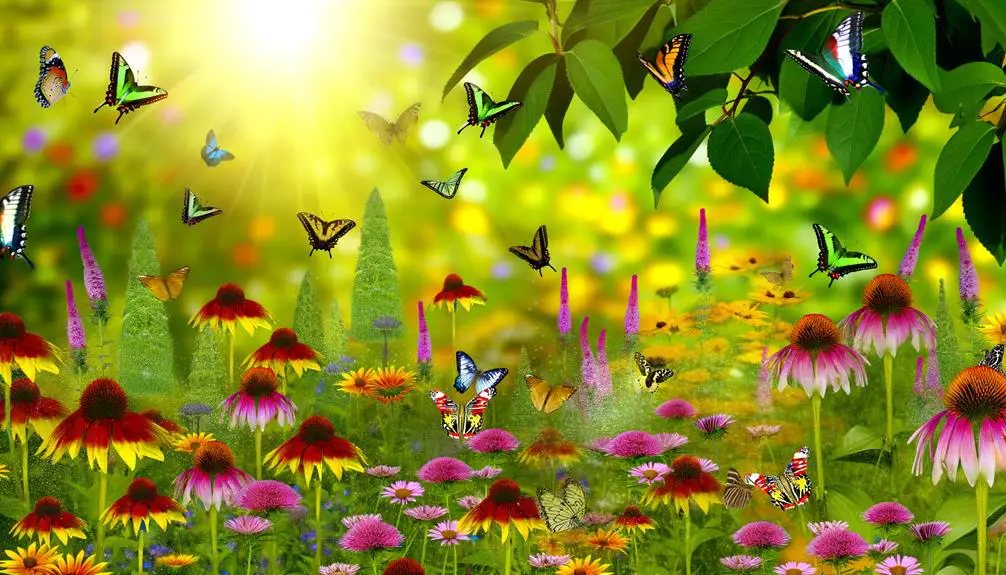
Key Takeaways
- Butterflies pollinate milkweed, essential for Monarchs, providing food and breeding grounds.
- Asters, blooming late summer to fall, attract butterflies and support migration.
- Coneflowers, with nectar-rich tubular florets, attract diverse butterfly species like Monarchs and Painted Ladies.
- Butterfly Bush's fragrant flowers in various colors are a major nectar source for numerous butterfly species.
Milkweed
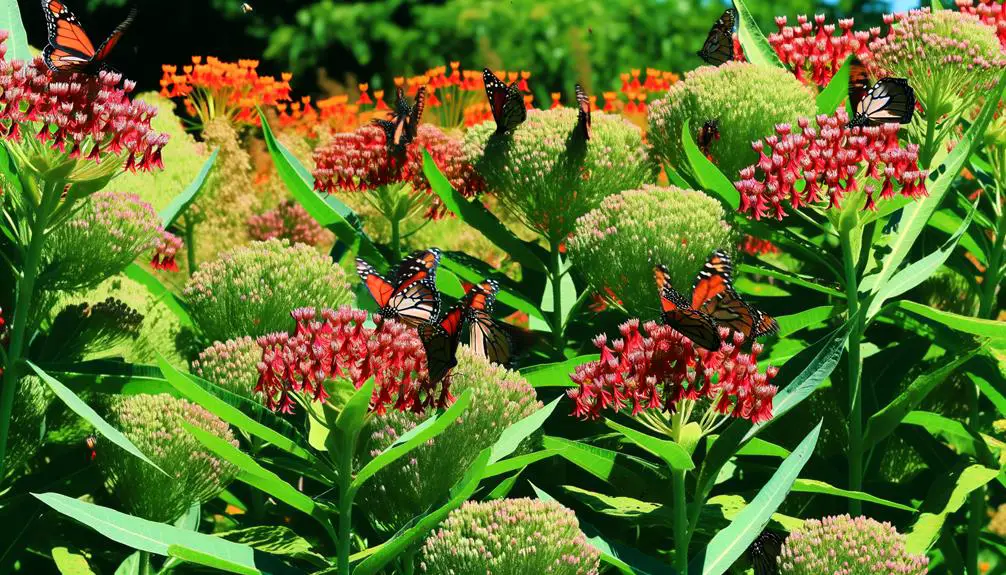
Milkweed (Asclepias spp.) serves as an important host plant for Monarch butterflies, providing both an essential food source and a breeding ground necessary for their life cycle.
The plant's unique chemical compounds, known as cardenolides or cardiac glycosides, are sequestered by Monarch larvae, rendering them toxic to potential predators. This chemical defense mechanism is critical for the larvae's survival.
In addition, milkweed offers a high-quality nectar source for adult butterflies, facilitating their reproductive processes. The intricate relationship between milkweed and Monarchs underscores the plant's ecological significance.
Effective habitat restoration and conservation efforts focusing on milkweed proliferation can greatly bolster Monarch populations, which are currently facing steep declines due to habitat loss and climate change. This symbiotic association exemplifies the delicate interdependence within ecosystems.
Asters
Asters, known for their extended blooming seasons spanning late summer through fall, provide critical nectar sources for butterflies during periods when other floral resources are scarce.
These plants employ visual and olfactory cues to attract butterflies, with their vibrant colors and fragrant compounds playing pivotal roles.
The mutualistic relationship between asters and butterflies enhances pollination efficiency and supports butterfly populations during migration.
Aster Blooming Seasons
Blooming mainly in late summer and fall, asters provide a crucial nectar source for butterflies during their migration periods.
These herbaceous perennials are part of the Asteraceae family, characterized by composite flower heads that offer abundant pollen and nectar.
The blooming season of asters aligns with the migratory patterns of many butterfly species, such as the monarch (Danaus plexippus), ensuring an essential energy source during long-distance travels.
The timing of aster blooming also fills a gap in floral resources, as many other plants cease flowering by late summer.
Consequently, asters contribute greatly to sustaining butterfly populations, supporting their reproductive success and enhancing biodiversity within ecosystems.
Butterfly Attraction Mechanisms
Asters employ various butterfly attraction mechanisms, including vivid coloration, enticing floral scents, and the strategic arrangement of their composite flower heads to maximize nectar accessibility.
The brilliant hues of asters, often in shades of purple, blue, pink, and white, are highly visible to butterflies, which rely on color vision to locate their food sources.
Additionally, asters emit specific volatile organic compounds that serve as olfactory cues, drawing butterflies from considerable distances.
The composite structure of aster flower heads, featuring numerous small florets clustered together, offers an ideal landing platform and facilitates efficient nectar extraction.
This arrangement guarantees that butterflies can easily access nectar while simultaneously promoting effective pollen transfer, enhancing the plant's reproductive success.
Coneflowers
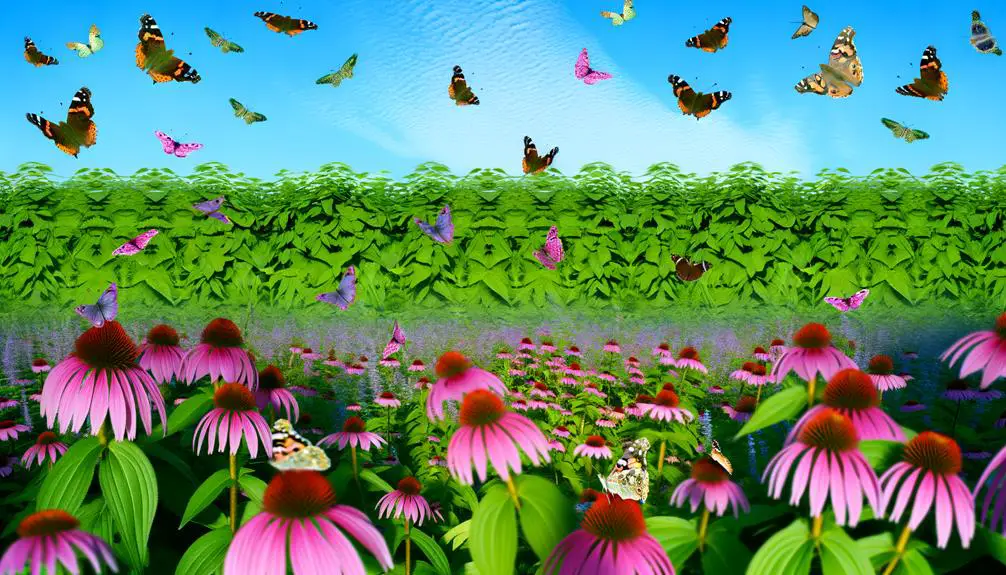
Coneflowers (Echinacea spp.), known for their vibrant petals and prominent central cones, are a significant source of nectar for various butterfly species. These perennial plants, native to North America, exhibit a composite inflorescence that attracts diverse Lepidoptera.
The nectar-rich tubular florets are particularly appealing to butterflies such as the Monarch (Danaus plexippus) and the Painted Lady (Vanessa cardui). The structure of coneflowers facilitates effective pollination, as butterflies inadvertently transfer pollen while feeding.
Echinacea species thrive in well-drained soils and full sun, contributing to their widespread cultivation in butterfly gardens. Their ecological role extends beyond pollination, as they support biodiversity by providing habitat and resources for other pollinators and beneficial insects.
Butterfly Bush
In addition to coneflowers, the Butterfly Bush (Buddleja davidii) serves as another essential nectar source, attracting a myriad of butterfly species with its dense clusters of fragrant, tubular flowers. This perennial plant is renowned for its ability to lure butterflies such as monarchs, swallowtails, and painted ladies. The Butterfly Bush thrives in well-drained soils and full sunlight, making it an ideal addition to butterfly gardens aiming to support pollinator populations. However, gardeners should be mindful of common pests on butterfly bush, such as spider mites and aphids, which can weaken the plant if left unchecked. Regular pruning and proper spacing can help maintain airflow and reduce pest infestations, promoting healthier growth. With proper care, the Butterfly Bush can provide a long-lasting nectar source, enhancing biodiversity in any pollinator-friendly garden.
| Butterfly Species | Emotional Impact on Gardeners |
|---|---|
| Monarch | Awe and admiration |
| Swallowtail | Delight and fascination |
| Painted Lady | Joy and enchantment |
| Red Admiral | Wonder and excitement |
The diverse hues of the Butterfly Bush's blossoms, ranging from deep purples to vibrant pinks, further enhance its appeal.
Lantana
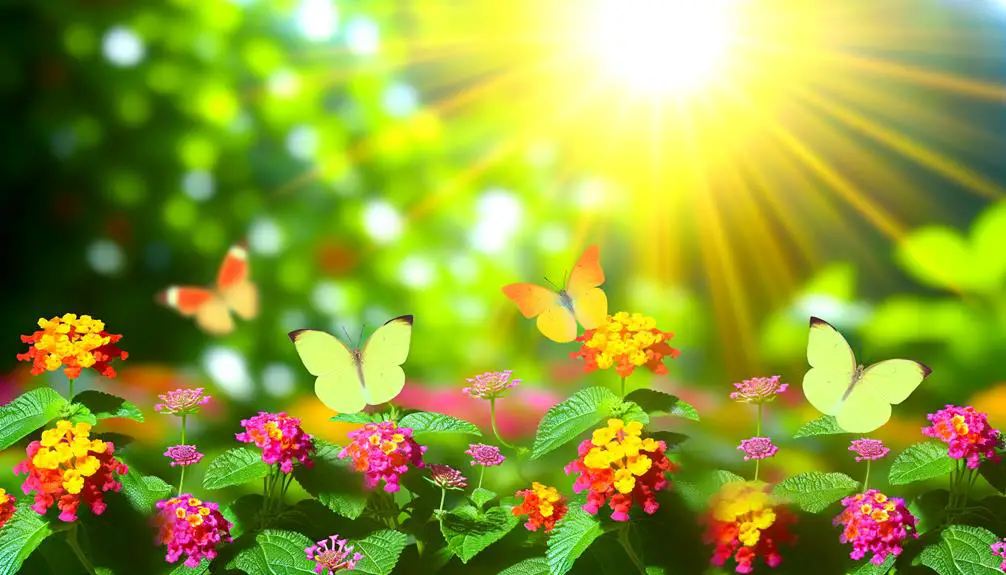
Lantana, known scientifically as *Lantana camara*, is a vibrant and hardy flowering plant that serves as a significant nectar source for various butterfly species.
This perennial shrub, native to tropical regions of the Americas, produces clusters of small, brightly colored flowers that are particularly attractive to butterflies. The tubular structure of Lantana flowers facilitates easy access to nectar, encouraging frequent visits by pollinators such as Monarchs, Swallowtails, and Painted Ladies.
The plant's extended blooming period, which can last from spring through fall, guarantees a consistent nectar supply.
Additionally, Lantana's adaptability to various soil types and resistance to drought conditions make it an ideal choice for butterfly gardens, enhancing both ecological value and aesthetic appeal.
Zinnias
Zinnias, belonging to the *Zinnia* genus, are recognized for their vibrant, long-lasting blooms that serve as an essential nectar source for a wide range of butterfly species.
These annual plants exhibit a diverse color palette, including shades of red, orange, pink, yellow, and white, which are highly attractive to butterflies.
The composite flower heads of zinnias present an easily accessible nectar source due to their open, flat structure. This morphological trait facilitates effective pollination as butterflies can efficiently retrieve nectar while transferring pollen.
Zinnias thrive in well-drained soil with ample sunlight, making them a resilient and low-maintenance choice for butterfly gardens.
Their extended blooming period guarantees a consistent nectar supply, supporting butterfly populations throughout the growing season.
Marigolds
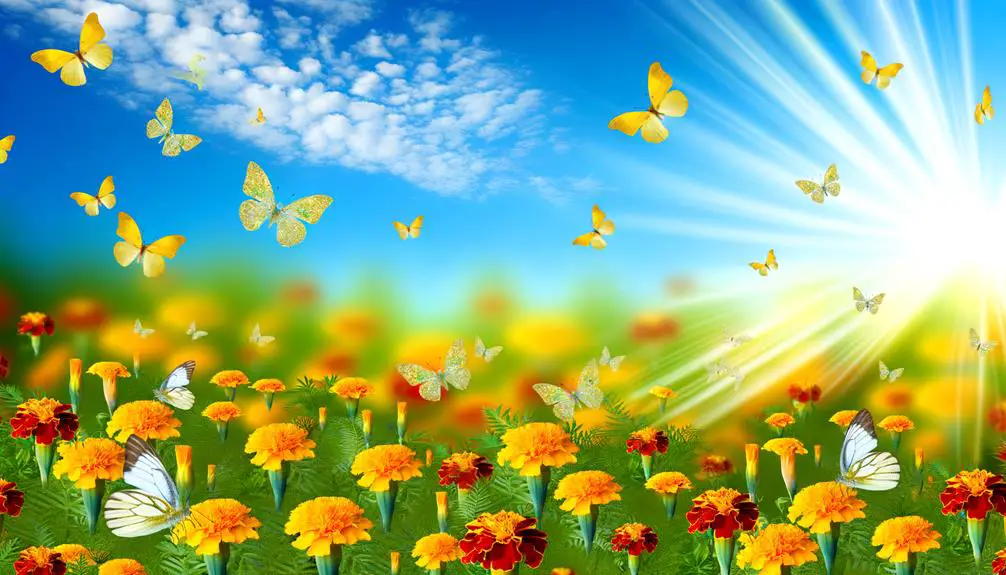
Marigolds, categorized under the genus *Tagetes*, are another valuable addition to butterfly gardens, known for their bright, aromatic flowers that attract a diverse array of butterfly species.
These annuals produce blooms in vivid hues of orange, yellow, and red, which are particularly appealing to butterflies. The flat-topped flower heads provide an accessible landing platform for butterflies, facilitating efficient nectar extraction.
Additionally, marigolds emit a strong fragrance that serves as a potent attractant. Their blooming period, which extends from late spring to autumn, guarantees a consistent nectar source throughout the growing season.
Marigolds also contribute to the biological control of pests, making them an ecologically beneficial choice for garden biodiversity and health.
Lavender
Lavender, scientifically known as *Lavandula*, is a perennial herb renowned for its aromatic purple flowers that are highly attractive to butterflies. This plant belongs to the Lamiaceae family and thrives in well-drained soils and full sun.
The tubular structure of lavender flowers facilitates efficient nectar extraction by butterflies, which possess long proboscises adapted for such tasks. Lavender's high nectar content provides a rich energy source, essential for the sustenance of butterflies.
Additionally, the vibrant purple hue acts as a visual attractant, drawing in various butterfly species. The symbiotic relationship between lavender and butterflies enhances cross-pollination, thereby promoting genetic diversity and plant health.
Understanding this dynamic underscores the ecological significance of lavender in butterfly habitats.
Sunflowers
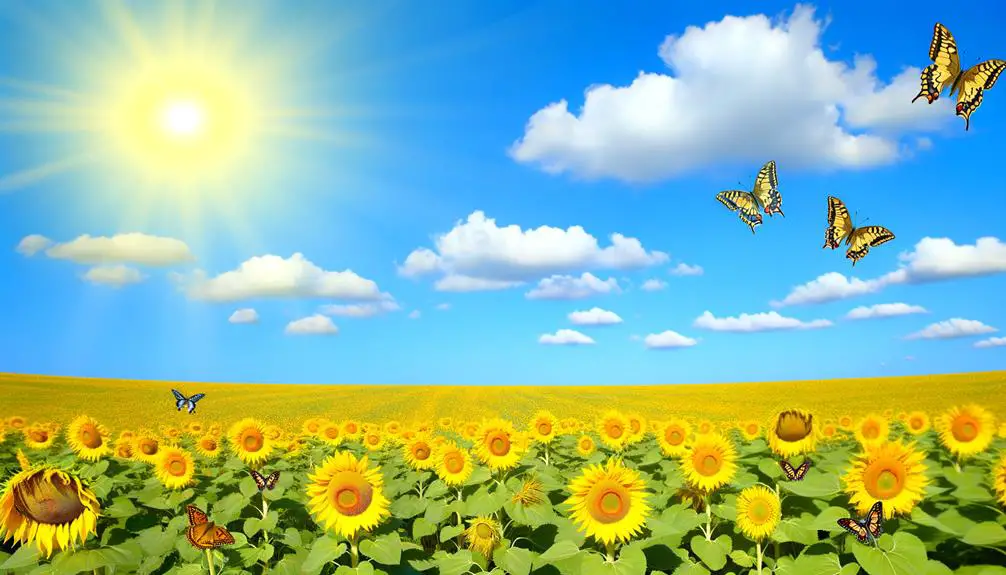
Sunflowers (Helianthus annuus) serve as an essential attractant for various butterfly species, including the Painted Lady and Monarch.
The intricate pollination process facilitated by these butterflies not only enhances genetic diversity within sunflower populations but also promotes robust seed development.
Consequently, this mutualistic interaction underscores the ecological significance of sunflowers in sustaining both butterfly populations and agricultural productivity.
Attracting Butterfly Species
Among the diverse array of flora that attract butterfly species, Helianthus annuus, commonly known as sunflowers, play a significant role due to their large, vibrant blooms and high nectar production.
These heliotropic plants' bright yellow petals and central disc florets serve as visual beacons for butterflies. The high nectar content within the disc florets provides an abundant food source, enhancing the sunflower's attractiveness.
Additionally, sunflowers offer landing platforms that accommodate various butterfly species. Their structural morphology, including the radial symmetry and openness of the flower heads, facilitates easy access to nectar.
This combination of visual appeal, nutritional value, and ease of access makes sunflowers a critical component in the habitat of butterfly species, thereby supporting pollinator biodiversity.
Pollination Process Benefits
The interaction between butterflies and Helianthus annuus not only enhances the reproductive success of sunflowers but also contributes to broader ecological benefits such as increased genetic diversity and ecosystem resilience.
Butterflies, through their pollination activities, facilitate cross-pollination, ensuring the spread of genetic material across different sunflower populations. This leads to stronger plant progeny and a higher resistance to diseases and environmental stresses.
In addition, the symbiotic relationship supports the food web, providing sustenance for various species.
- Enhanced Genetic Diversity: Cross-pollination introduces varied genetic traits, promoting robust populations.
- Ecosystem Resilience: Diverse sunflower populations can better withstand environmental changes.
- Nutrient Cycling: Pollination contributes to the continuation of plant life cycles, aiding soil health.
Conclusion
Butterflies serve as essential pollinators for a diverse array of plants, including milkweed, asters, coneflowers, butterfly bush, lantana, zinnias, marigolds, lavender, and sunflowers.
These plants benefit from the intricate pollination mechanisms facilitated by butterflies, ensuring genetic diversity and ecosystem stability.
Is it not evident that the preservation of butterfly habitats is imperative for the sustained propagation of such important flora?
The symbiotic relationship between butterflies and these plants underscores the importance of conservation efforts.

